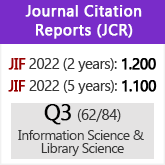Measuring the presence of the Spanish language on the Internet: methods and results
DOI:
https://doi.org/10.3989/redc.2016.3.1328Keywords:
Cybermetric language, Linguistic diversity, measuring languages, multilingualism in cyberspace, Spanish on the Internet, presence of languages on the InternetAbstract
This paper summarizes recent studies that explore and analyze the situation of the Spanish language on the Internet and infers methodological lessons that could be useful for similar studies for other languages. The method was first used to obtain results for the state of French on the Internet in a study funded by the Organisation internationale de la Francophonie. By taking into account a selection of web spaces and commonly used applications, Spanish could be ranked between third and fourth place in terms of Internet usage (whereas it is third in terms of Internet users), occupying the top positions for P2P, videos and blogs, but having a minor role in terms of books, webpages and applications. Thus Spanish on the Internet appears to act more dynamically as a vector for communication than for information.
Downloads
References
Alexa - http://alexa.com [diciembre 2014].
Calvet L.-J. (2012). Poids des langues (Baromètre Calvet) - http://wikilf.culture.fr/barometre2012/ [marzo 2014].
CISCO, Cisco Visual Networking Index - http://www. cisco.com/c/en/us/solutions/service-provider/ visual-networking-index-vni/ [diciembre 2014].
Dilinet - http://dilinet.org [diciembre 2014].
Estudio lenguas y ciberespacio en Unión Latina http:// dtil.unilat.org/LI/2007/index_es.htm [julio 2012].
Ethnologue: Languages of the World - http://www.sil. org/ethnologue [mayo 2013].
Funredes, Fundación Redes y Desarrollo - http:// funredes.org [diciembre 2014].
Grefenstette y Nioche J. (2001). Estimation of English and non English Language use on the WWW. Technical report from Xerox Corporation Center Europe. - http://arxiv.org/ftp/cs/ papers/0006/0006032.pdf [marzo 2014].
InternetWorldStats - http://www.internetworldstats. com/stats7.htm [diciembre 2013].
LOP, Language Observatory Project - http://gii2. nagaokaut.ac.jp/gii/blog/lopdiary.php [julio 2012].
Maaya, Red Mundial por la diversidad lingüística - http://maaya.org [mayo 2015].
Netcraft - http://news.netcraft.com/archives/category/ web-server-survey/ [marzo 2015].
Net.Lang : Réussir le cyberespace multilingue / Towards a multilingual cyberspace (2012), Paris, C&F Éditions. Consultable igualmente en http:// net-lang.net/ [diciembre 2014].
Observatorio de lenguas y culturas en la Internet en Funredes - http://funredes.org/lc [julio 2012].
OIF (Organisation internationale de la francophonie). La langue française dans le monde (2014) - http:// www.francophonie.org/Langue-Francaise-2014/ [junio 2016].
Paolillo J.; Pimienta D.; Prado D.; Mikami Y.; Zaki abu Bakar A.; Sonlertlamvanich V.; Vikas O.; Pavol Z.; Zaidi abdul Rozan M.; Nagy János G.; Takahashi T.; Fantognan X. (2005). Mesurer la diversité linguistique dans l’Internet, Paris, UNESCO – Consultable igualmente en http://unesdoc.unesco. org/images/0014/001421/142186f.pdf [diciembre 2014].
Pimienta D. (2011). Chapter 12, Language and Content, pp183-197, in Accelerating Development Using the Web. Gorge Sadowsky (ed.), Word Wide Web Foundation. http://g3ict.org/download/p/ fileId_928/productId_241.
Pimienta D.; Prado D.; Blanco A. (2009). Douze ans de mesure de la diversité linguistique dans l’Internet: bilan et perspectives, Paris, UNESCO – Consultable igualmente en http://unesdoc.unesco. org/images/0018/001870/187016f.pdf [diciembre 2014].
Prado D.; Pimienta D.; Lemoulinier A. (2010). Diversité linguistique et cyberespace : état de l’art, enjeux et opportunités en Cosmopolis, - http:// agora.qc.ca/cosmopolis.nsf/Articles/no2010_1_ Diversite_linguistique_et_cyberespace___etat_ de_l?OpenDocument [diciembre 2014].
Socialbakers - http://www.socialbakers.com/statistics/ [diciembre 2015].
Suzuki I.; Mikami Y.; Ohsato A.; Chubachi Y. (2002). A Language and Character Set Determination Method based on N-gram Statistics, ACM Trans. on Asian Language Information Processing, Vol 1 N3, pp. 270- 279.http://dx.doi.org/10.1145/772755.772759
UIT, (2010). Monitoring the WSIS Targets. A mid-term review, Target 9 (content) en World Telecommunication/ICT Development Report 2010 (pp175-192). Ginebra, UIT – Consultable igualmente en http://www.itu.int/pub/D-IND-WTDR-2010 [diciembre 2014].
Unión Latina - http://unilat.org/ (consultado en mayo 2015).
Union latine (2010): Présence, poids et valeur des langues romanes dans la société de la connaissance, actes de la journée d’étude du 30 avril 2010 (sous la direction de Daniel Prado), Paris. Unión Latina
W3Techs - http://w3techs.com/technologies/overview/ content_language/all [diciembre 2014].
Wikipedia, lenguas del mundo - https://es.wikipedia. org/wiki/Familia_de_lenguas [diciembre 2014].
Published
How to Cite
Issue
Section
License
Copyright (c) 2016 Consejo Superior de Investigaciones Científicas (CSIC)

This work is licensed under a Creative Commons Attribution 4.0 International License.
© CSIC. Manuscripts published in both the printed and online versions of this Journal are the property of Consejo Superior de Investigaciones Científicas, and quoting this source is a requirement for any partial or full reproduction.All contents of this electronic edition, except where otherwise noted, are distributed under a “Creative Commons Attribution 4.0 International” (CC BY 4.0) License. You may read here the basic information and the legal text of the license. The indication of the CC BY 4.0 License must be expressly stated in this way when necessary.
Self-archiving in repositories, personal webpages or similar, of any version other than the published by the Editor, is not allowed.

















